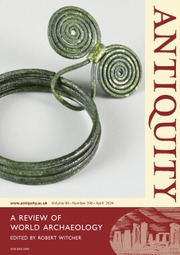No CrossRef data available.
Article contents
Blade and microblade industry at Helong Dadong, north-east China, during Marine Isotope Stage 2
Published online by Cambridge University Press: 21 October 2024
Abstract

Characterised by the extensive use of obsidian, a blade-based tool inventory and microblade technology, the late Upper Palaeolithic lithic assemblages of the Changbaishan Mountains are associated with the increasingly cold climatic conditions of Marine Isotope Stage 2, yet most remain poorly dated. Here, the authors present new radiocarbon dates associated with evolving blade and microblade toolkits at Helong Dadong, north-east China. At 27 300–24 100 BP, the lower cultural layers contain some of the earliest microblade technology in north-east Asia and highlight the importance of the Changbaishan Mountains in understanding changing hunter-gatherer lifeways in this region during MIS 2.
Keywords
- Type
- Research Article
- Information
- Copyright
- Copyright © The Author(s), 2024. Published by Cambridge University Press on behalf of Antiquity Publications Ltd


